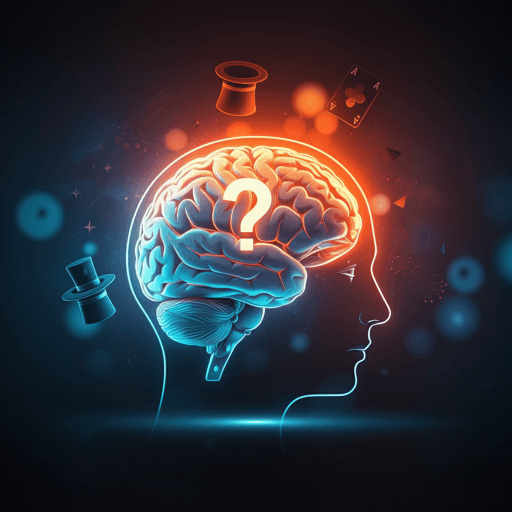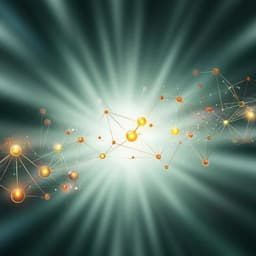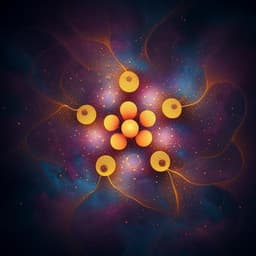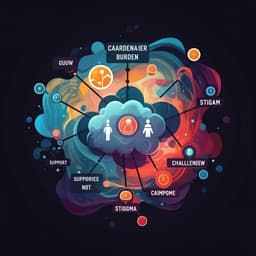
Psychology
Broad brain networks support curiosity-motivated incidental learning of naturalistic dynamic stimuli with and without monetary incentives
S. Meliss, A. Tsuchiyagaito, et al.
Curiosity—the intrinsic desire to know—boosts memory and shows reward-like effects, but how does it interact with extrinsic incentives during naturalistic learning? Across two behavioral studies (N₁ = 77, N₂ = 78) and one fMRI study (N = 50) using magic-trick videos, this research found that curiosity and incentives independently enhanced encoding and produced distinct memory and brain-network signatures. Research conducted by Stefanie Meliss, Aki Tsuchiyagaito, Phoenix Byrne, Carien van Reekum, and Kou Murayama.
~3 min • Beginner • English
Introduction
The study investigates how surprise-based curiosity and monetary incentives affect incidental learning of dynamic, naturalistic stimuli and their neural correlates. Prior work using trivia questions suggests that curiosity and rewards both enhance memory via dopaminergic and hippocampal mechanisms, but it is unclear whether these effects generalize to complex, time-varying stimuli and whether curiosity and incentives interact. The authors used magic trick videos to elicit surprise-based curiosity and manipulated the availability of monetary incentives on a concurrent judgment task to test additive or interactive effects on memory and brain activity. They hypothesized that curiosity and incentives would each facilitate encoding, potentially via hippocampal–VTA circuits, and explored whether incentives would preferentially benefit low-curiosity items.
Literature Review
Existing research shows humans seek information even at a cost, and information can function as a reward engaging striatal and vmPFC systems. Curiosity, often studied with trivia paradigms (knowledge-gap elicitation), enhances both intentional and incidental encoding at short and long delays, with hippocampus, nucleus accumbens, and VTA/SN implicated—especially under high-curiosity states and with increased mesolimbic–hippocampal connectivity. Reward/incentive studies show monetary incentives enhance intentional and incidental encoding, also engaging NAcc, HPC, and VTA/SN during anticipation, consistent with dopamine-modulated hippocampal LTP. Few studies test curiosity and incentives together; some find interactions where rewards preferentially enhance less interesting items, though evidence is mixed. Curiosity can also arise from context-based prediction errors (surprise, expectation violations), with magic tricks effectively eliciting such curiosity and engaging ventral striatum in risky curiosity-driven decisions. The current work addresses gaps by using naturalistic magic tricks to probe surprise-based curiosity and by jointly examining curiosity and incentives behaviorally and neurally.
Methodology
Design: Three studies with a shared structure. Participants watched 36 magic trick videos, made an estimate judgment (how many people could figure out the solution), rated trial-wise curiosity (1–7), and, for half the sample, received monetary incentives for correct estimates (judgment pseudo-task, not memory). Incidental memory was probed one week later via cued recall and 4-alternative forced-choice recognition with confidence ratings. Task motivation was assessed via TMI.
Study 1 (Behavioral): Online via Prolific, two sessions 1 week apart. Final N = 77 (control n = 38; incentive n = 39). Incentive: £0.10 per correct estimate. Stimuli: 36 MagicCATs magic trick videos (20–60 s), edited for uniformity; cue images captured pre-surprise for memory tasks. Magic trick viewing task: post-video estimate (0–10%, 11–20%, 21–30%, ≥31%) and curiosity rating. Memory after ~7 days: cued free recall and 4AFC recognition (self-paced) with confidence (1–6). TMI subscales: intrinsic motivation, task engagement, interest, boredom, effort, pressure. Data collection approved by University of Reading SREC (2016-109-KM).
Study 2 (Behavioral replication): Online via Prolific; target n ≈ 40 per group. Final N = 78 (control n = 40; incentive n = 38). Incentive framing: potential 50% bonus payment translating to ~£0.10 per correct estimate; participants reimbursed £7.50 plus £0.90 bonus (chance-level). Same stimuli and procedures; minor wording adjustments in recognition items; full pressure scale in TMI.
Study 3 (fMRI): Lab-based; N = 50 right-handed participants (25 per group). Incentive wording matched replication study (stated 50% bonus; operationalized as £0.80 per correct estimate). Sessions: pre-scan online assessment, fMRI magic trick task with pre-/post-resting-state (10 min each; resting data not analyzed here), and online surprise memory ~1 week later. MRI acquisition: 3T Siemens Prisma, 32-channel coil; EPI, TR = 2000 ms, TE = 30 ms, 37 axial slices, 3×3×3 mm, 0.75 mm gap; preprocessing with B0 distortion correction, despiking, slice timing and motion correction, MNI normalization (ICBM 2009c), smoothing to ~8 mm FWHM, scaling, nuisance regression (local WM, ventricle PCs, motion), band-pass 0.01–0.1 Hz, censoring for motion/outliers. Task: videos aligned to TR; 6 s mock video intro; jittered fixation (4–10 s, even TRs); fixed response windows (estimate 6 s, curiosity 5.95 s); colored button responses on MRI-compatible box; pseudo-randomized trial orders balancing high/low curiosity items. Incentive manipulation presented and confirmed before each block.
Analyses (Behavioral): gLME models per dataset and memory measure (recognition regardless of confidence; high-confidence recognition defined as correct with confidence >3; cued recall), with fixed effects for curiosity (participant mean-centered), incentives (effect-coded), and their interaction; random intercepts for participants and stimuli; random slopes for curiosity. Integration via fixed-effects meta-analysis (metafor) across the three datasets. Exploratory: vary recognition confidence cut-off (0 to 5) and regress integrated effects on cut-off.
Analyses (fMRI): Intersubject correlation (ISC) computed after concatenating stimulus time series (removing non-stimulus volumes; aligning orders across subjects; shifting by HRF lag determined via ISPC to 4 TRs; robustness checked across lags). Pairwise voxelwise correlations (AFNI 3dTcorrelate) yielded 1225 ISC maps (Fisher z-transformed). Group-level ISC via LME with crossed random effects (AFNI 3dISC), coding pairwise group composition (both control, mixed, both incentive). Intersubject representational similarity analysis (IS-RSA): compute subject-by-subject similarity matrices for behavior and brain; anchor idiosyncratic neural responses to behavioral similarity in (1) curiosity (trial-wise ratings; residualized for memory), (2) memory (trial-wise high-confidence encoding; residualized for curiosity), and (3) curiosity-motivated learning enhancement (CMLE; individual random slopes of curiosity predicting high-confidence recognition from gLME; Anna Karenina model using pairwise means). LME-CRE models with fixed effects for group, behavioral similarity, and their interaction predicted pairwise ISC. Thresholding: whole-brain cluster-extent with initial p=0.001, NN=1, α=0.05, k=20 (AFNI 3dClustSim). ROIs: anterior hippocampus (aHPC; Glasser atlas; y=21P cut), nucleus accumbens (NAcc), caudate nucleus (CN), and VTA/SN (Pauli atlas; 15% probability); ROI results FDR q=0.05 with k≥5. Unthresholded maps available on NeuroVault; full MRI dataset and code publicly accessible.
Key Findings
Behavioral:
- Curiosity enhanced memory encoding, significantly for high-confidence recognition and cued recall, but not for overall recognition: High-confidence recognition b=0.084 (SE=0.022), OR=1.09 [1.04–1.14], z=3.766, p<0.001; Cued recall b=0.098 (SE=0.025), OR=1.10 [1.05–1.16], z=3.842, p<0.001; Recognition (all confidence) b=0.023 (SE=0.023), OR=1.02 [0.98–1.07], z=0.988, p=0.323.
- Monetary incentives increased encoding, significantly for high-confidence recognition: High-confidence recognition b=0.155 (SE=0.067), OR=1.17 [1.03–1.33], z=2.336, p=0.019; Recognition b=0.084 (SE=0.050), OR=1.09 [0.99–1.20], z=1.676, p=0.094; Cued recall b=0.119 (SE=0.075), OR=1.13 [0.97–1.30], z=1.599, p=0.110.
- No curiosity × incentive interaction for any memory measure (all p≥0.290).
- Confidence-threshold analysis: Curiosity effect increased with higher confidence cut-offs (slope B=0.021, 95% CI [0.011, 0.031], p=0.004), whereas incentive (B=−0.012, 95% CI [−0.049, 0.024], p=0.402) and interaction effects were insensitive to confidence (B=−0.007, 95% CI [−0.018, 0.003], p=0.122). Interpretation: curiosity preferentially enhances recollection-like memory; incentives affect encoding more broadly, regardless of confidence.
fMRI (ISC):
- Robust ISC across widespread cortical and subcortical regions during magic trick viewing, including bilateral visual cortex, parietal somatosensory and attention areas (BA 2, 5, 7, 39, 40), premotor/SMA (BA 6, 8), with significant ISC also in aHPC, VTA/SN, NAcc, and CN ROIs.
- Incentive availability modulated ISC in cortical regions: higher ISC in incentive group in left middle occipital gyrus, right postcentral gyrus (BA 2), and right intraparietal sulcus; higher ISC in control group in left lateral occipital cortex (V5/MT+). No incentive effects in reward ROIs.
fMRI (IS-RSA):
- Curiosity similarity (unique effects) predicted neural similarity in cortical areas including left V1, right inferior frontal gyrus (pars opercularis), bilateral SMA (BA 8), left postcentral gyrus, left precuneus (BA 7), right anterior insula, and right supramarginal gyrus.
- Memory similarity (unique effects) anchored neural similarity in bilateral caudate (ROI) and widespread cortex (visual areas; superior/middle frontal gyri BA 46/9-46/6/8; precuneus BA 7; angular gyrus BA 39; somatosensory BA 2/40; left fusiform/inferior temporal BA 37; right V5/MT+; right anterior insula).
- CMLE (curiosity–memory association) showed significant IS-RSA effects in all ROIs (right aHPC, right VTA/SN, bilateral CN, bilateral NAcc), predominantly negative: participants with low CMLE had more similar neural time courses; high CMLE showed more idiosyncratic, variable dynamics. Whole-brain CMLE effects included a small number of positive clusters (bilateral middle temporal gyrus, left middle occipital gyrus, right calcarine, right postcentral) and many negative clusters spanning DMN, FPN, dorsal/ventral attention networks, thalamus, striatum, cerebellum, and visual cortex.
- Incentive × behavior interactions in IS-RSA occurred outside reward ROIs: curiosity-by-incentive effects in bilateral occipital cortex (greater prediction in control); memory-by-incentive effects in bilateral calcarine (greater in incentive), and left dlPFC/middle occipital (greater in control); CMLE-by-incentive effects broadly in posterior and frontal cortical regions, with more positive values in incentive than control in many clusters.
Discussion
Curiosity and incentives each facilitated incidental memory encoding for dynamic, naturalistic stimuli without interacting, diverging from some trivia-based findings. A key behavioral dissociation emerged: curiosity benefits were specific to high-confidence recognition and recall (recollection-like processes), whereas incentive effects extended to memory irrespective of confidence, aligning with theories that intrinsic motivation relates to performance quality and extrinsic incentives to performance quantity. Neurally, using intersubject synchronization suited to naturalistic stimuli, the study observed widespread cortical synchrony and behavioral–neural correspondences. Contrary to a reward-network-centric view, curiosity-related neural similarity localized to cortical regions implicated in uncertainty processing, appraisal, attention, and prediction-error processing (IFG, SMA, anterior insula, IPL/precuneus), suggesting that surprise-based curiosity engages broader evaluative and attentional systems. Memory similarity anchored in the caudate supports its role in prediction error and schema updating during encoding of incongruent events. CMLE effects within hippocampal–VTA/striatum ROIs were predominantly negative, indicating that stronger curiosity–memory coupling is associated with more individualized neural dynamics rather than synchronized, exogenous processing—consistent with endogenous engagement during curiosity-driven encoding. Incentive effects on neural synchrony were found primarily in occipital and parietal attention-related regions, suggesting that incentives may modulate attentional alignment rather than time-locked reward responses in mesolimbic structures under naturalistic viewing. Overall, these results challenge a narrow focus on reward circuits for curiosity and highlight distributed network contributions under naturalistic, dynamic conditions.
Conclusion
The study demonstrates that surprise-based curiosity, elicited by magic tricks, enhances incidental memory for dynamic stimuli and that monetary incentives also improve encoding, with no interaction between them. Curiosity’s benefits are specific to high-confidence recognition and recall, whereas incentive effects are less dependent on confidence. fMRI analyses reveal that curiosity and incentive effects are supported by broad cortical networks involved in uncertainty, appraisal, and attention, with memory and curiosity–memory coupling also engaging mesolimbic–hippocampal regions but in a time-varying, idiosyncratic manner. These findings expand the understanding of curiosity-motivated learning beyond classical reward-network accounts, emphasizing the importance of naturalistic paradigms and intersubject approaches. Future work should examine diverse stimuli and more direct incentive manipulations, refine modeling of dynamic neural responses, and translate insights to educational practice to leverage curiosity and motivation for improved learning outcomes.
Limitations
- Incentive manipulation targeted a concurrent judgment task (pseudo-task) rather than memory performance, potentially reducing salience and contributing to the absence of curiosity × incentive interaction.
- Use of naturalistic, dynamic stimuli complicates direct comparison with traditional GLM-based findings; ISC assesses synchrony in time courses, not absolute activation magnitude, which may miss tonic group differences.
- Cluster-extent thresholding (initial p=0.001; k=20) may limit detection of effects in small structures; ROI thresholding (FDR q=0.05; k≥5) balances sensitivity and false positives but can miss subtle effects.
- Inter-rater reliability for cued recall coding was low–moderate (κ=0.47); main analyses focused on recognition to mitigate this issue.
- Some gLME models produced singular fit warnings; reduced random-effects models were used for robustness checks.
- fMRI sample included only right-handed participants; generalizability to broader populations may be limited.
- Incentive wording inconsistencies (e.g., bonus per correct estimate in fMRI study) noted though not reported as affecting behavior.
- Budget-constrained sample sizes, though meta-analytic integration and pairwise ISC increased statistical power.
- No feedback during estimate task; participants may have been uncertain about “correct” estimates, potentially affecting engagement with incentives.
Related Publications
Explore these studies to deepen your understanding of the subject.







